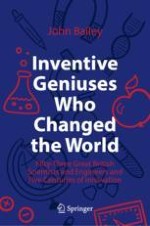Abstract
For over two millennia, philosophers and scientists had theorized about the composition of matter. Between 1803 and 1932, four British scientists (viz Dalton, J.J. Thomson, Rutherford and Chadwick) put forward an increasingly sophisticated architectural model of matter. John Dalton found that the total pressure created by a mixture of gases is the sum of their partial pressures. In 1803, he asserted that all matter, whether gas, liquid or solid, is composed of small, indivisible particles. All atoms of one element are identical to each other but different from other elements. A chemical reaction is simply a rearrangement of atoms. According to his law of multiple proportions, in a chemical reaction, atoms combine in small whole number ratios. In 1884, Joseph J. Thomson succeeded his tutor, Lord Rayleigh, as Cavendish Professor of Experimental Physics at the University of Cambridge. Thomson was awarded the Nobel Prize in Physics, in 1906, for his theoretical and experimental investigations into the conduction of electricity by gases. In an evacuated glass vessel, he produced cathode rays—negatively charged particles in transverse motion. Thomson identified a universal constituent of matter and effectively overturned Dalton’s indivisibility hypothesis. This fundamental particle was later given the name “electron”. Electrons are the most useful of the sub-atomic particles because of their detachability. Background scientists such as Davy and Faraday exploited their loose boundedness to produce electricity. Applied technologists such as W. Thomson, Bell and others utilised them to bring about the electric telegraph, telephones, electric generators and motors, and the electronics industry—encapsulating smart phones and computers. In microchips, electrons are shuffled around in a way prescribed by computer code. The chemical properties of elements are defined by the properties of orbital electrons, whilst radioactivity is determined by the nature of the nucleus. F. Aston, working with J. J. Thomson, identified two isotopic forms of neon. Aston would go on to use their electro-magnetic focusing technique to identify 212 of the 254 naturally occurring, stable isotopes. He was awarded the Nobel Prize in Chemistry, in 1922. Ernest Rutherford was a student of J. J. Thomson, and possibly the greatest experimentalist since Faraday. He was the central figure in the study of radioactivity. He studied two of the three types of radiation emitted by uranium which he named α-rays and β-rays. Using similar techniques to Thomson, he showed that α-rays are helium ions (He2+) whilst β-rays are, like cathode rays, electrons. Rutherford and F. Soddy collaborated on the theory of radioactive disintegration and the transmutation (rearrangement) of nuclei and atoms. For his contribution, together with his investigation into the chemistry of radioactive substances, Rutherford received the Nobel Prize in Chemistry in 1908. Contrary to Dalton’s view of the atom, he demonstrated that an atom can be ‘destroyed’. Loss of an alpha particle means a lowering of the mass number by 4 and atomic number by 2. He observed that any quantity of radioactive isotope takes the same amount of time for half of it to decay. This constant rate of decay can be used as a ‘clock’ to gauge the age of such things as rocks, fossils etc. via radiometric dating. In 1911, Rutherford proposed a ‘nuclear model’ of the atom in which its mass is concentrated in a dense, positively charged nucleus, with electrons orbiting at some distance from the nucleus. This crude template was refined both by N. Bohr, who proposed that electrons orbited at set distances from the nucleus and, later, by E. Schrödinger, who suggested regions of space where an electron will probably be. In 1919, Rutherford investigated the nuclear transformation of a non-radioactive element to another element. The result of this prompted him to postulate that the hydrogen nucleus is a primordial, fundamental particle which he dubbed the ‘proton’. It is no longer thought to be indivisible. He further observed that about one half of the mass of the nuclei he had investigated could be ascribed to protons. He and Bohr theorized about the existence of a particle which would nullify the repelling effect of positively charged protons confined in an atomic nucleus. In his final years of research, he used particle accelerators to fuse together small nuclei, noting the high level of energy associated with the nuclear conversions. Frederick Soddy, Niels Bohr, as well as eleven other collaborators and students researching with Rutherford would eventually receive Nobel prizes in their own sphere of scientific expertise. James Chadwick and Rutherford studied the transmutation of non-radioactive elements such as beryllium (4Be9) by bombarding them with α-particles. Chadwick proved that radiation emitted from beryllium was more energetic than could be accounted for by γ-rays. Particles ejected from various targets were uncharged; had a mass slightly heavier than a proton and were more penetrating than protons. He demonstrated experimentally the existence of ‘neutrons’, what he thought was a new fundamental particle. So important was his finding that, three years later, he was awarded the Nobel prize in physics, in 1935. His work marked the start of nuclear physics. Accelerated neutrons do not have to overcome any repulsive barriers of charged particles. This feature provides a tool for inducing atomic disintegration since neutrons are capable of penetrating and splitting the nuclei of the heaviest elements. When there is a critical amount of fission material, and other conditions are met, a self-sustaining chain reaction can occur with the release of a vast amount of atomic energy. Neutrons can mediate a nuclear chemical reaction and this property led to the atomic bomb and, later, to nuclear power production. Between 1897 and 1932, the experimental research of Thomson, Rutherford and Chadwick identified three sub-atomic particles, namely the electron, proton, and neutron.
